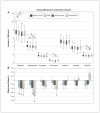Identifying common and distinct subcortical volumetric abnormalities in 3 major psychiatric disorders: a single-site analysis of 640 participants
- PMID: 35728922
- PMCID: PMC9343126
- DOI: 10.1503/jpn.210154
Identifying common and distinct subcortical volumetric abnormalities in 3 major psychiatric disorders: a single-site analysis of 640 participants
Abstract
Background: Subcortical volumetric abnormalities in schizophrenia, bipolar disorder and major depressive disorder (MDD) have been consistently found on a single-diagnosis basis in previous studies. However, whether such volumetric abnormalities are specific to a particular disorder or shared by other disorders remains unclear.
Methods: We analyzed the structural MRIs of 160 patients with schizophrenia, 160 patients with bipolar disorder, 160 patients with MDD and 160 healthy controls. We calculated the volumes of the thalamus, hippocampus, amygdala, accumbens, putamen, caudate, pallidum and lateral ventricles using FreeSurfer 7.0 and compared them among the groups using general linear models.
Results: We found a significant group effect on the volumes of the thalamus, hippocampus, accumbens and pallidum. Further post hoc analysis revealed that thalamic volumes in patients with schizophrenia, bipolar disorder and MDD were significantly reduced compared to those in healthy controls, but did not differ from one another. Patients with schizophrenia and bipolar disorder also shared a significant reduction in hippocampal volumes. Among the 3 clinical groups, patients with schizophrenia showed significantly lower hippocampal volumes and higher pallidal volumes than patients with bipolar disorder and MDD.
Limitations: Differences in psychotropic use and duration of illness among the patient groups may limit the interpretation of our findings.
Conclusion: Our findings indicate that decreased thalamic volume is a common feature of schizophrenia, bipolar disorder and MDD. Smaller hippocampal and larger pallidal volumes differentiate schizophrenia from bipolar disorder and MDD and may provide clues to the biological basis for the Kraepelinian distinction between these illnesses.
© 2022 CMA Impact Inc. or its licensors.
Conflict of interest statement
Competing interests: None declared.
Figures


Similar articles
-
Differences in subcortical brain volumes among patients with schizophrenia and bipolar disorder and healthy controls.J Psychiatry Neurosci. 2022 Mar 1;47(2):E77-E85. doi: 10.1503/jpn.210144. Print 2022 Mar-Apr. J Psychiatry Neurosci. 2022. PMID: 35232800 Free PMC article.
-
Subcortical volumetric alterations in four major psychiatric disorders: a mega-analysis study of 5604 subjects and a volumetric data-driven approach for classification.Mol Psychiatry. 2023 Dec;28(12):5206-5216. doi: 10.1038/s41380-023-02141-9. Epub 2023 Aug 4. Mol Psychiatry. 2023. PMID: 37537281 Free PMC article.
-
Disorder-specific volumetric brain difference in adolescent major depressive disorder and bipolar depression.Brain Imaging Behav. 2014 Mar;8(1):119-27. doi: 10.1007/s11682-013-9264-x. Brain Imaging Behav. 2014. PMID: 24158718
-
Neuroimaging hippocampal subfields in schizophrenia and bipolar disorder: A systematic review and meta-analysis.J Psychiatr Res. 2018 Sep;104:217-226. doi: 10.1016/j.jpsychires.2018.08.012. Epub 2018 Aug 7. J Psychiatr Res. 2018. PMID: 30107268 Review.
-
Cross disorder comparisons of brain structure in schizophrenia, bipolar disorder, major depressive disorder, and 22q11.2 deletion syndrome: A review of ENIGMA findings.Psychiatry Clin Neurosci. 2022 May;76(5):140-161. doi: 10.1111/pcn.13337. Epub 2022 Feb 26. Psychiatry Clin Neurosci. 2022. PMID: 35119167 Free PMC article. Review.
Cited by
-
Cumulative Impact of Morphometric Features in Schizophrenia in Two Independent Samples.Schizophr Bull Open. 2023 Nov 4;4(1):sgad031. doi: 10.1093/schizbullopen/sgad031. eCollection 2023 Jan. Schizophr Bull Open. 2023. PMID: 39145335 Free PMC article.
-
A Systematic Review and Narrative Synthesis of Cognitive Training in the Treatment of Mental Illness and Substance Use Disorder.J Clin Med. 2024 Jul 25;13(15):4348. doi: 10.3390/jcm13154348. J Clin Med. 2024. PMID: 39124616 Free PMC article. Review.
-
Increased [18F]Fluorodeoxyglucose Uptake in the Left Pallidum in Military Veterans with Blast-Related Mild Traumatic Brain Injury: Potential as an Imaging Biomarker and Mediation with Executive Dysfunction and Cognitive Impairment.J Neurotrauma. 2024 Jul;41(13-14):1578-1596. doi: 10.1089/neu.2023.0429. Epub 2024 May 8. J Neurotrauma. 2024. PMID: 38661540
-
Morphological Abnormalities in Early-Onset Schizophrenia Revealed by Structural Magnetic Resonance Imaging.Biology (Basel). 2023 Feb 23;12(3):353. doi: 10.3390/biology12030353. Biology (Basel). 2023. PMID: 36979045 Free PMC article.
-
[Anatomic Abnormalities of Hippocampal Subfields in First-Episode Drug-Naïve Schizophrenia and Major Depressive Disorder: A Structural MRI Comparative Study].Sichuan Da Xue Xue Bao Yi Xue Ban. 2023 Mar;54(2):275-280. doi: 10.12182/20230360209. Sichuan Da Xue Xue Bao Yi Xue Ban. 2023. PMID: 36949685 Free PMC article. Chinese.
References
-
- Kraepelin E. Dementia praecox and paraphrenia. Edinburgh: Livingstone; 1919.
-
- American Psychiatric Association. Diagnostic and statistical manual of mental disorders. Fifth edition. Arlington (VA): American Psychiatric Association Publishing; 2013.
-
- Rimol LM, Hartberg CB, Nesvåg R, et al. . Cortical thickness and subcortical volumes in schizophrenia and bipolar disorder. Biol Psychiatry 2010;68:41–50. - PubMed

